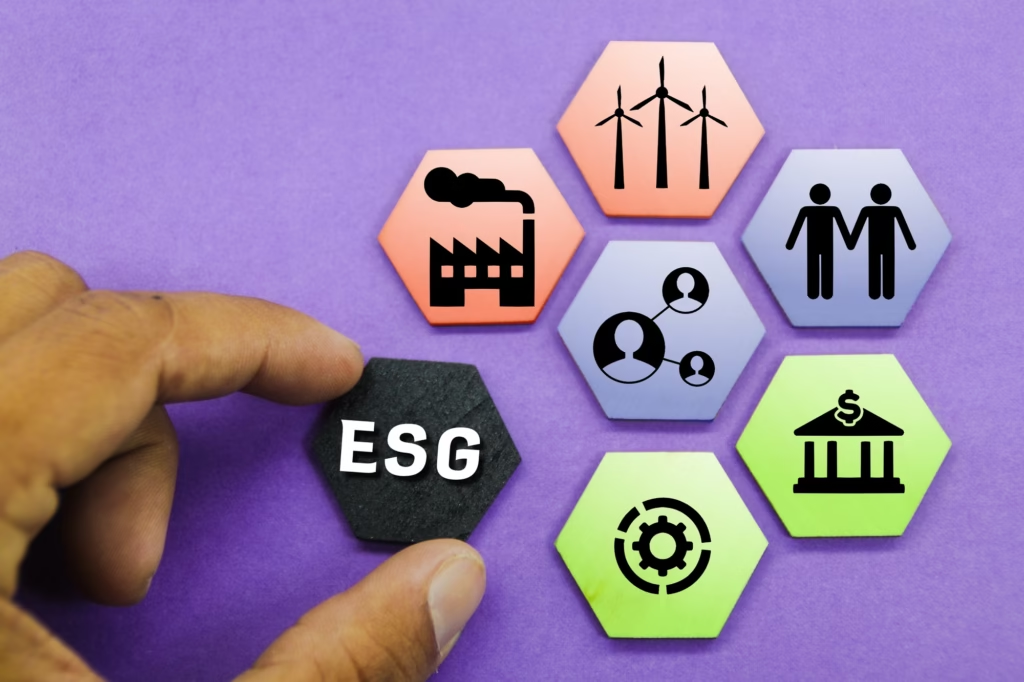
Introduction to ESG Reporting
In recent years, ESG reporting has emerged as a critical element within the corporate strategy of businesses worldwide. ESG, which stands for Environmental, Social, and Governance, encompasses a set of standards measuring a company’s impact on the environment, its relationships with stakeholders, and its governance practices. The significance of this reporting lies in its ability to provide stakeholders, including investors, employees, and customers, with crucial insights into a company’s ethical performance and sustainability efforts.
The growing demand for transparency and accountability has led to an increased focus on ESG reporting. Stakeholders are increasingly aware of the implications of a company’s operations on the planet and society, prompting them to seek out organizations that prioritize sustainability. As a result, companies that produce an ESG report can enhance their reputation, attract investment, and foster positive relationships with consumers and partners. The practice of ESG reporting is not meerely a trend but a reflection of a broad shift towards responsible business conduct.
Moreover, ESG reporting serves as a tool for organizations to evaluate their practices and identify areas for improvement. By analyzing specific ESG reporting examples from other companies, businesses can benchmark their performance against industry standards and devise strategies to enhance their impact. This approach not only fulfills stakeholder expectations but also contributes to long-term profitability and resilience in an evolving marketplace.
Incorporating ESG metrics into the operational framework allows companies to collectively understand their role in promoting sustainable development. This understanding promotes informed decision-making and builds a corporate culture focused on positive impact. Ultimately, embracing ESG reporting is essential for any business that aims to thrive in today’s landscape, where social responsibility and environmental stewardship are increasingly important criteria for success.
Understanding ESG Criteria
Environmental, Social, and Governance (ESG) criteria form the core framework by which organizations assess their sustainability and ethical impact. Each pillar encompasses a distinct area of focus, enabling a comprehensive evaluation of a company’s overall practices and their alignment with responsible business operations.
The first pillar, Environmental criteria, examines how a corporation performs as a steward of nature. This can include metrics such as carbon emissions, energy efficiency, waste management, and resource depletion. Organizations can enhance their ESG report by providing data on their initiatives to mitigate environmental impacts, such as adopting renewable energy sources or implementing waste reduction programs. For example, a corporation might measure its progress by calculating its carbon footprint and outlining steps taken to achieve net-zero emissions.
The second pillar, Social criteria, assesses how a company manages relationships with employees, suppliers, customers, and the communities where it operates. Metrics associated with social criteria may include labor practices, workplace diversity, community engagement, and human rights efforts. ESG reporting examples in this category can highlight employee satisfaction surveys, diversity statistics, or community outreach initiatives that demonstrate a company’s commitment to social responsibility.
The third pillar, Governance, focuses on a company’s leadership, internal controls, and stakeholder relations. Key metrics involve company policies on ethics, board diversity, and executive compensation structures. A robust ESG report often details governance practices, such as how a company ensures transparency in its decision-making processes or manages shareholder rights. Aligning governance structures with corporate strategy can lead to long-term value creation.
Companies that effectively integrate these ESG criteria into their core operations not only meet stakeholder expectations but also enhance their competitiveness and adaptability in a rapidly evolving business landscape. In developing an ESG report, understanding and measuring performance in these areas is essential for demonstrating a genuine commitment to sustainable practices.
Benefits of ESG Reporting for Businesses
Producing an ESG report delivers several critical advantages that can significantly enhance a business’s overall performance and sustainability strategy. First and foremost, enhanced reputation is a key benefit. Companies that engage in transparent ESG reporting demonstrate a commitment to ethical practices and social responsibility, which can improve public perception and brand loyalty. Stakeholders, including investors and customers, increasingly favor organizations that align with their values, making ESG components essential in fostering a positive brand image.
Another notable advantage of effective ESG reporting is improved risk management. By identifying, measuring, and disclosing environmental, social, and governance risks, businesses can better prepare for potential challenges in their operations. This proactive approach not only minimizes vulnerabilities but also aligns with long-term strategic planning. Integrating ESG considerations into the corporate framework can result in a more resilient business model that thrives amid changing market dynamics.
Access to capital is yet another critical benefit derived from comprehensive ESG reporting. Investors and financial institutions are increasingly scrutinizing ESG factors as a measure of potential returns and risks. Companies with robust ESG reports are often viewed as less risky investments, attracting capital from socially responsible investors. This heightened visibility can improve funding opportunities and lead to lower capital costs, effectively contributing to business growth.
Additionally, ESG reporting can attract conscious consumers who prioritize sustainability. As awareness regarding environmental and social issues rises, consumers are gravitating towards brands that prioritize ESG practices. By clearly communicating commitments through well-structured reports, businesses can not only meet consumer expectations but also gain a competitive edge in their markets. Overall, ESG reporting is not merely a regulatory requirement; it is a strategic asset that can drive long-term success.
Steps to Creating Your First ESG Report
Creating an effective ESG report is a structured process that necessitates careful planning and execution. The first step involves identifying stakeholders, which includes understanding who will be impacted by the report and who should provide input. Stakeholders may include employees, customers, suppliers, investors, and local communities. Engaging these parties early in the process ensures that their concerns and expectations are addressed in your ESG reporting.
The next phase is determining the scope of the report. This involves defining which environmental, social, and governance aspects are relevant to your business and its operations. The scope will also determine the timeline and resources required for the report. Selecting material topics that align with stakeholder interests and sustainability goals is crucial for delivering a meaningful ESG report.
Gathering data forms the foundation of your report. Companies should collect quantitative and qualitative data relevant to the identified ESG topics. This includes metrics on energy consumption, waste management, workforce diversity, and compliance with regulations. Reliable data collection methods bolster the credibility of the ESG report and facilitate assessment against set benchmarks.
After data collection, businesses should establish specific ESG goals that support long-term sustainability. These can range from reducing carbon emissions to enhancing community engagement. Setting these goals provides direction and helps measure progress over time, reinforcing the company’s commitment to its ESG initiatives.
Once the data and goals are established, drafting the ESG report becomes the next priority. This document should communicate findings transparently and clearly, emphasizing the company’s approach and achievements in relation to the set ESG goals. Finally, businesses must address any regulatory requirements related to ESG reporting. Understanding local regulations and ensuring compliance will add credibility to your efforts and foster stakeholder trust.
Top ESG Reporting Examples
In recent years, the importance of ESG reporting has significantly increased as stakeholders demand more transparency regarding environmental, social, and governance practices from organizations. Notable examples of effective ESG reports can be found across various industries, providing valuable insights into best practices and innovative approaches that resonate with stakeholder expectations.
One prominent example comes from the technology sector, where companies like Microsoft have published comprehensive ESG reports. Their reports highlight commitment to sustainability by showcasing a clear path toward carbon negativity by 2030. Microsoft’s dedication to responsible sourcing and ethical AI provides stakeholders with insights into their overarching governance structures, setting a high bar for ESG reporting standards within the tech industry.
In the energy sector, BP has made strides in aligning its ESG report with global climate goals. The company’s transition from fossil fuels to renewable energy sources is detailed in their annual ESG report, illustrating not only their accountability but also their strategy towards a sustainable future. By breaking down specific targets, such as reducing operational emissions, BP exemplifies clarity and ambition in its ESG reporting.
Additionally, in the manufacturing industry, Unilever stands out for its comprehensive approach. The company’s ESG report integrates its Sustainable Living Plan, which outlines measurable objectives tied to social and environmental impacts. By engaging diverse stakeholder groups and openly addressing challenges, Unilever’s practices reflect an understanding of the growing demand for accountability in ESG matters.
These case studies underscore the evolving nature of ESG reporting. They demonstrate how aligning your organization’s values with clear, data-driven reporting not only enhances credibility but also fosters trust among stakeholders. As businesses seek to navigate the complexities of ESG reporting, these examples serve as benchmarks for organizations aiming to enhance their own reports to meet stakeholder expectations effectively.
Overcoming Common Challenges in ESG Reporting
As businesses embark on the journey of creating their first ESG report, they often encounter several challenges that can impede the process and affect the quality of their disclosures. One of the primary difficulties lies in data collection. Gathering accurate and relevant information across various departments can be daunting, especially when there is no standardized procedure in place. Companies must integrate disparate data sources and ensure that they capture the necessary metrics for comprehensive ESG reporting. A practical solution for this challenge is to establish a centralized data management system that allows for seamless data aggregation from different units, thus enhancing the coherence and reliability of the information presented.
Additionally, standardization issues frequently arise in ESG reporting. Various reporting frameworks, such as the Global Reporting Initiative (GRI) and the Sustainability Accounting Standards Board (SASB), present different criteria and guidelines. This inconsistency can lead to confusion in understanding what data needs to be reported. To address this, businesses should identify which framework aligns most closely with their industry standards and stakeholder expectations. By developing a clear mapping process to these frameworks, organizations can cultivate alignment in their reporting efforts, facilititating a more standardized approach and minimizing discrepancies across reporting periods.
Another challenge that organizations may face is potential bias in the ESG report. This can occur if companies selectively present data that demonstrates a more favorable outcome while omitting less flattering information. This not only undermines the credibility of the ESG report but can also lead to regulatory scrutiny. To mitigate bias, organizations should consider implementing a third-party review process, wherein an independent entity assesses the report for accuracy and balance. Moreover, providing detailed FAQs related to the ESG report can enhance transparency and address stakeholder questions head-on, thereby bolstering trust in the organization’s commitment to sustainability.
Future Trends in ESG Reporting
The landscape of Environmental, Social, and Governance (ESG) reporting is continuously evolving, driven by advancements in technology, regulatory changes, and increasing stakeholder expectations. One notable trend is the rise of digital reporting tools that streamline the process for organizations. These platforms enable businesses to efficiently gather, analyze, and disclose ESG-related data, making it more accessible for stakeholders. As digital tools become increasingly sophisticated, they will allow companies to present their ESG report in a more visually compelling and easy-to-understand format.
Moreover, the integration of artificial intelligence (AI) in data analysis is transforming ESG reporting. Organizations are harnessing AI-driven analytics to assess risk factors more effectively, track sustainability goals, and enhance overall reporting accuracy. This technological innovation not only aids in identifying trends but also facilitates deeper insights into ESG performance metrics. Businesses leveraging AI in their ESG efforts prepare for more robust reporting, ultimately leading to improved compliance and accountability.
Alongside technological advancements, there is a growing wave of regulatory pressures surrounding ESG practices. Governments and regulatory bodies worldwide are implementing stricter requirements for ESG disclosures, rendering it crucial for businesses to stay informed and compliant. Thus, organizations must adapt their ESG reporting practices to meet these evolving standards while also responding to the increasing demands of investors, consumers, and other stakeholders who seek transparency and accountability in corporate practices.
In light of these emerging trends, organizations must remain agile and proactive in enhancing their ESG reporting strategies. Adopting new technologies, responding to regulatory changes, and understanding stakeholder expectations will empower businesses to stay ahead in the ESG space, ensuring they not only fulfill requirements but also drive meaningful impact through their sustainability initiatives.
FAQs About ESG Reporting
In recent years, the focus on ESG (Environmental, Social, and Governance) criteria has intensified, prompting many businesses to consider how to approach their first ESG report. One common question is: how do we begin an ESG report? The first step is to define what ESG means for your business and its specific context. Engaging with stakeholders is critical to understand their expectations and requirements, ensuring that the report reflects the right priorities and metrics.
Another frequent inquiry pertains to what stakeholders are looking for in an ESG report. Generally, stakeholders favor transparency and measurable outcomes that demonstrate a company’s commitment to sustainable practices. This includes how the business mitigates environmental impact, promotes social wellbeing, and ensures robust governance structures. It’s essential for the report to address key performance indicators (KPIs) pertinent to these areas, supplemented with relevant data and narratives that illustrate performance over time.
Many are also curious about the differences between ESG reports and CSR (Corporate Social Responsibility) reports. While CSR reporting often focuses on social initiatives and community impacts, ESG reports take a broader perspective that includes environmental effects and governance practices. ESG reporting emphasizes data accuracy and stakeholder accountability, making it crucial for investors looking to assess long-term viability.
Another point businesses often raise is the frequency of publishing ESG reports. It is generally advised that companies release an ESG report annually to stay relevant and provide stakeholders with up-to-date information. However, depending on the industry and stakeholder demands, more frequent updates or supplemental disclosures may be necessary. By prioritizing these aspects in ESG reporting, companies can enhance their credibility and demonstrate a commitment to responsible practices, while also engaging with the insights and standards relevant to various reporting frameworks such as the Global Reporting Initiative or the Sustainability Accounting Standards Board.
Conclusion
As businesses navigate the increasingly complex landscape of sustainability and corporate responsibility, embracing ESG reporting emerges as a critical component of long-term success. This guide has outlined the essential elements to consider when compiling your first ESG report, emphasizing the importance of transparency and accountability in today’s corporate governance. By incorporating relevant ESG reporting examples, organizations can benchmark their progress and demonstrate their commitment to ethical practices.
Engagement in ESG reporting not only aids in compliance with evolving regulations but also plays a significant role in attracting investors, customers, and talent who prioritize sustainability. Companies with robust ESG reports are often viewed more favorably in the market, which can lead to enhanced reputation and competitive advantage. Understanding the complexity of ESG metrics and how they influence stakeholder perception is vital.
For those keen to begin their journey in ESG reporting, consider starting with a self-assessment of current practices to identify areas for improvement. This preliminary step can illuminate the organization’s existing strengths and weaknesses in sustainability efforts. Alternatively, seeking external expertise, like consultancy services from firms such as Infotyke, can provide additional insights and best practices that can significantly enhance the quality of your ESG report. Collaborating with experienced professionals ensures that your report aligns with industry standards and reflects genuine commitment to impactful corporate responsibility.
In conclusion, the creation of your ESG report is not merely an exercise in compliance or marketing; it is an opportunity to lead your organization towards a sustainable and responsible future. Take the first step today and make ESG reporting a cornerstone of your business strategy. Your commitment to transparency can pave the way for sustainable growth and bolster your reputation in an increasingly conscientious market.








